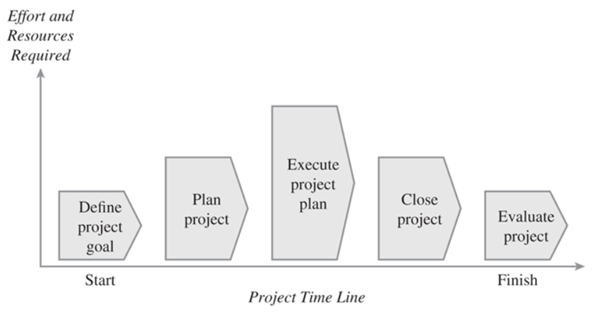Project Time Line

A project is large or small, projects are organized into sequential phases to make the project more manageable and to reduce risk. Phase exits, stage gates, or kill points are the phase-end reviews that allow the organization to evaluate the project’s performance and to take immediate action to correct any problems or even cancel the project. Fast tracking, or starting the next phase before the current phase is complete, can sometimes reduce the project’s schedule, but the overlapping of phases can be risky and should only be done when the risk is deemed acceptable.

- Define Project Goal – All projects have a beginning. Although a project is initiated when someone comes up with a new idea for perhaps a new product, service, or system, the first step in beginning a project should be to define the project’s goal. The project’s goal should make explicit the project’s envisioned business value because projects are organizational investments that require time and resources and involve risk. A well-defined goal will set stakeholders’ expectations and drive the other phases of the project. The project goal should also answer the question: How will we know if this project is successful given the time, money, and resources invested? Once the project’s goal has been clearly defined, it must be agreed upon by the project stakeholders before the project can begin the planning phase.
- Plan Project – The project’s goal provides direction for planning the project; otherwise, it would be like driving a car without a destination in mind. A project plan defines:
- Project Objectives – A project’s objectives include scope (the project work), schedule, budget, and quality. Objectives support the project’s goal by defining what work needs to be completed, when it needs to be completed, how much it will cost to complete, and whether the work is acceptable to specific stakeholders.
- Resources – Resources are needed to complete the project work and include such things as people, facilities, and technology.
- Controls – A great deal of managing a project includes ensuring that the project goal and objectives are being met and resources are used efficiently and effectively. In addition, risk, change, and communication among the project stakeholders must be proactively managed throughout the project.
- Execute Project Plan – Approval of the project plan is required before moving to the execution phase. While the plan projectphase outlines the anticipated or planned progress of the project, the execute project plan phase concentrates on the design, development, and delivery of the project’s product, service, or system. Moreover, the controls defined in the planning phase now allow the project stakeholders to compare the project’s planned progress with the actual progress in terms of the work being completed on time, within budget, and within quality standards so as to achieve the business value envisioned. At the end of this phase, the team implements or delivers a completed product, service, or information system to the organization.
- Close and Evaluate Project – A project should have a definite end. The last phases ensure that all of the work is completed as agreed to by the team, the sponsor, or other stakeholders. However, the project and the project team should be evaluated during a postmortem review to determine whether the project’s goal defined in the initial phase was achieved. In addition, any best practices based on experiences and lessons learned should be documented and made available to future projects.
In addition, most projects seem to share the following characteristics:
- The effort, in terms of cost and staffing levels, is low at the start of the project, but then increases as the project work is being done, and then decreases at the end as the project is completed.
- Risk and uncertainty are the highest at the start of a project.
- For many projects, the ability for stakeholders to influence the product’s features or functionality is highest at the beginning of the project. The cost of changing the product’s features or functionality and correcting errors becomes more expensive as the project progresses.
Resource :
Jack T. Marchewka. (2016). Information Technology Project Management: Providing Measurable Organizational Value. 5. Wiley. –. ISBN: 978-1118911013.

